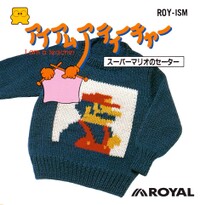I am a teacher: Super Mario Sweater: Difference between revisions
From the Super Mario Wiki, the Mario encyclopedia
Jump to navigationJump to search
No edit summary |
mNo edit summary |
||
| Line 1: | Line 1: | ||
[[Image:Mario sweater.jpg|thumb|The cover of ''I Am a Teacher: Super Mario Sweater''.]] | [[Image:Mario sweater.jpg|thumb|The cover of ''I Am a Teacher: Super Mario Sweater''.]] | ||
'''I Am a Teacher: Super Mario Sweater''', or ''I Am a Teacher: Super Mario no Sweater'' is [[Famicom Disk System]] game released on August 27, 1986 only in Japan. It was devised by Royal industries Co. Ltd., a Japanese appliance and sewing machine company. | '''''I Am a Teacher: Super Mario Sweater''''', or ''I Am a Teacher: Super Mario no Sweater'' is a [[Famicom Disk System]] game released on August 27, 1986 only in Japan. It was devised by Royal industries Co. Ltd., a Japanese appliance and sewing machine company. | ||
The company realized that they could make a lot of money by releasing a sweater-design program, which led to this game. Players could design the sweater they want, and the company would make a real-life version for 2,900 Yen (about $24 in US Dollars). | The company realized that they could make a lot of money by releasing a sweater-design program, which led to this game. Players could design the sweater they want, and the company would make a real-life version for 2,900 Yen (about $24 in US Dollars). | ||
Revision as of 21:04, August 15, 2011
I Am a Teacher: Super Mario Sweater, or I Am a Teacher: Super Mario no Sweater is a Famicom Disk System game released on August 27, 1986 only in Japan. It was devised by Royal industries Co. Ltd., a Japanese appliance and sewing machine company.
The company realized that they could make a lot of money by releasing a sweater-design program, which led to this game. Players could design the sweater they want, and the company would make a real-life version for 2,900 Yen (about $24 in US Dollars).
Sources
- Slashdot
- Gamespot
- Princess Peach's castle: screenshots and images of children wearing the final products.
This article is a stub. Please consider expanding it to include any missing information.
